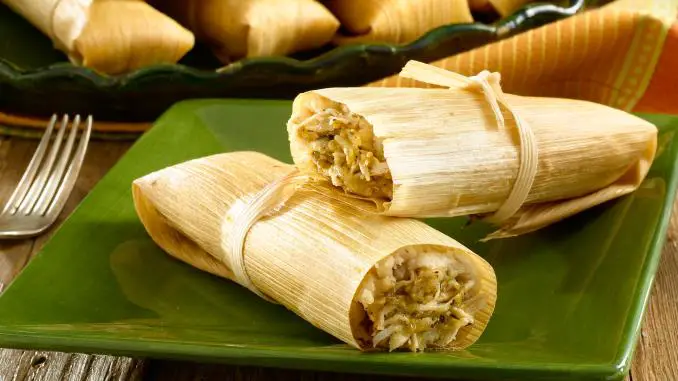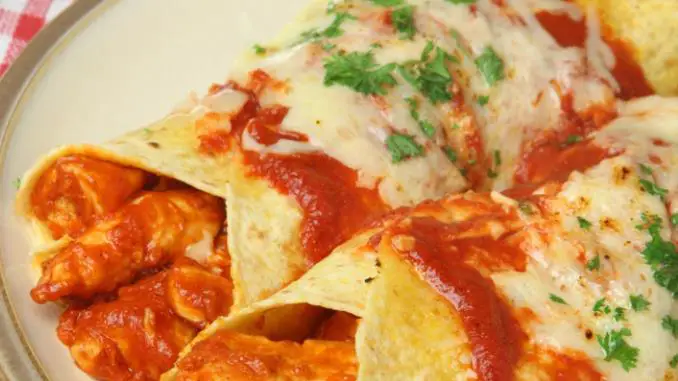Because of their classic flavor and modern twist, enchiladas and tamales are both appealing and popular. As a result, they make excellent snacks because they can both be consumed quickly on the run.
However, many individuals are confused by the similarities between these two. Their cooking methods and ingredients, though, are distinct. This article will provide you with some clues and perspectives to distinguish between enchiladas and tamales.
Related: Top 30 Most Popular Mexican Dishes to Try
Enchilada
Enchilada (Spanish spelling: enchiladas, pronounced “en-chee-LAH-daz”) was invented as a delicious way to use up leftovers in Mexico. Corn tortillas from the day before are cooked briefly in oil, dipped in chili sauce, rolled around the filling (usually meat or fish), and baked. Enchilada in Spanish means “chili-flavored,” so this meal will have some heat, for sure.
Adding a lot of tomato sauce, sour cream, and cheese to a dish appears to be a Tex-Mex invention. Outside of Mexico, wheat flour tortillas are frequently used rather than corn tortillas. Enchiladas are the ultimate comfort meal, whether you choose the original Mexican or international Tex-Mex version.
The use of tortillas as a wrap has most likely been practiced for millennia. Tortillas were a staple of the Maya and Aztec diets, and Spanish explorers traveling through Mexico in the sixteenth century encountered plenty of enchiladas. According to legend, the original enchiladas were stuffed with fish.
Enchiladas are also mentioned in the first known Mexican cookbook, El Cocinero Mexicano (The Mexican Cook), published in 1831. Fillings in the nineteenth century were a little less complicated than we are accustomed to, for example, olives with onions or picadillos (pork with onion). Cheese was occasionally strewn over them.
Tamale
Tamales (pronounced “ta-MAA-les”) are steamed maize flour dumplings filled with meat, vegetables, or dried fruit. They’re a popular street food snack in Mexico that may be consumed anytime from early in the morning as a quick breakfast to late at night. The texture is soft and fluffy.
The masa (nixtamalized maize flour soaked in an alkaline solution) lard dough and the corn cob or banana leaf wrap are the most critical components. Carnitas (pulled pork) with chili sauce, green vegetables, or even sweet items like raisins, fresh fruit, or dulce de leche can all be used as fillings.
Tamales were thought to be an ancient dish, maybe dating back to 100 AD. There are shards of evidence, such as illustrations. According to ancient cultures, tamales are a portable snack, as they can be carried when hunting or traveling across great distances.
Tamales were regarded as sacred since they were thought to be the meal of the gods. The Aztecs, Maya, Olmeca, and Tolteca were thought to be civilizations that grew corn.
The Main Differences Between Enchiladas and Tamales
Origins (are they Mexican?)
Enchiladas are thought to have originated in Mexico, where the Aztecs invented wrapping tortillas around other dishes. People living in the valley of Mexico’s lake region used to consume corn tortillas folded or rolled around tiny fish.
Also, enchiladas were listed as part of the remembrance of Mexican cuisine in the first Mexican cookbook, El Cocinero Mexicano (The Mexican Chef), published in 1831, and in Mariano Galván Rivera’s Diccionario de Cocina, published in 1845.
The Nahuatl word tamalli is the source of the term “tamales.” Tamale remnants have been discovered going back to 8000 B.C., and the meal was popular with the Aztecs, Mayans, Olmec, Toltecs, and even the Incas.
It’s supposed that the dumplings were first cooked directly in the fire, resulting in brown, crispy tamales. Steaming the dumplings became popular only when the Spanish colonists introduced new culinary techniques in the sixteenth century. The dish is currently popular in Mexican restaurants across the United States, Europe, and Central and South America.
Food ingredients
If you want modern yet classic Mexican enchiladas, the chef will start by making a chili sauce to flavor the enchiladas. The sauce is created using ancho, guajillo, dried jalapeños, tomatoes, garlic, onion, and sour cream.
Corn tortillas are then fried in oil before being dipped on both sides in the sauce, which is then stuffed with your choice of filling, such as chicken, minced meat, or a vegetarian option.
Finally, cheese is occasionally added, but it is usually placed on top. The enchiladas are traditionally baked in the oven until everything is warm, which is an optional step.
The ingredients of tamales are slightly different. Fresh masa (corn dough) should be pale, light, and fluffy after being beaten with lard. Place a tablespoon of this mixture on a moistened corncob leaf.
In the absence of a corn leaf, cooks add a mix of greaseproof paper and aluminum foil. Place a layer of filler on top of that — usually meat in a tomato or chili sauce. Extras, such as olive, can now be added.
After that, wrap the leaves into a thick cigar shape. The masa has now fully encased the filling. After that, steam the tamales for 45 minutes to an hour.
How to Make Enchiladas and Tamales
The difference between an enchilada and a tamale is that an enchilada is prepared by wrapping meat in a corn tortilla, but a tamale is produced by steaming meat in a green or hot red sauce in corn husks. Inside the tortilla of an enchilada is a sweet-spicy sauce. In addition, the enchilada has a more extensive filling.
The meat is wrapped in a tortilla made of corn dough to make an enchilada. The essence within the tortilla is more filling in an enchilada. It has a sweet-spicy sauce in it, which makes it spicy without being overpowering. It doesn’t have any cheese in it. After that, it’s cooked in hot oil.
Tamale is a traditional Mexican meal. Corn husks or banana leaves are used to make it. It has a steamed inside. It comes with a red or green hot sauce. In tamales, the filling is modest. It does, however, include cheese. The tamale is puffy and filled with chicken or pork before being cooked in a saucepan.
Sauce
In terms of authenticity, there is no such thing as a single enchilada sauce. Instead, to coat a tortilla and make an enchilada, use any pureed salsa recipe. Enchilada sauce is a variant of a salsa roja used to create a meal called “enchiladas rojas” as most Americans know it.
Except for a few regional variants, tamales are rarely served with sauce on top; this is more of a Tex-Mex phenomenon. Tamale fillings, on the other hand, are frequently created using salsas that have been reduced.
The ingredients, not the method of preparation, characterize all salsas. However, traditional foods, such as my favorite enchiladas, enchiladas suizas, have a conventional salsa recipe.
Toss a fresh or canned tomatillo salsa with some fresh or sour cream, coat warmed tortillas in the mixture, load with chicken or cheese, top with additional sauce and cheese, and broil until melted.
Conclusion
That concludes our tutorial and recommendations on how to distinguish between the tamale and enchilada. I hope you now have a better understanding of these two well-known cuisines so you can cook them at home!
So, what are you waiting for? Let’s make an excellent supper of enchiladas or tamales for your friends and family, shall we?
More From Mama Say What?!
Chalupa vs Tostada: Can You Name These Differences?
Enchilada vs Tamale: Can You Spot These Differences?
The post Enchilada vs Tamale: Can You Spot These Differences? first appeared in Mama Say What?!






